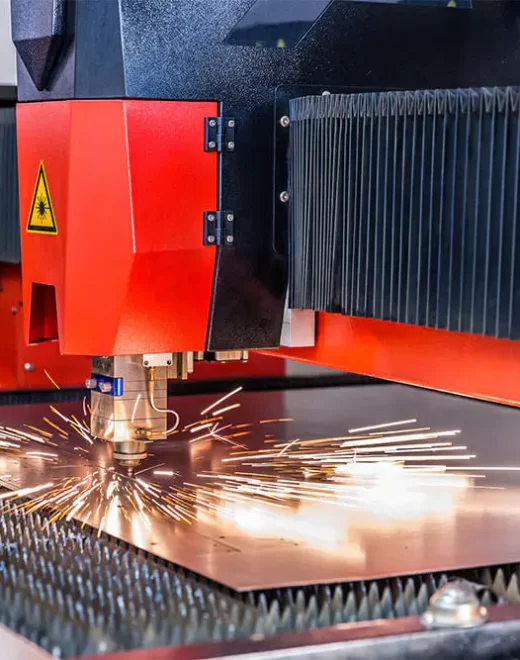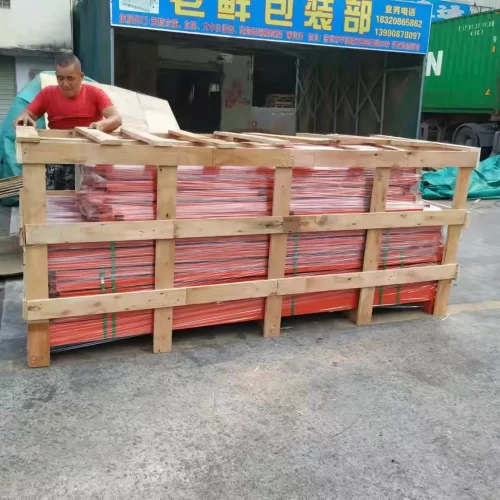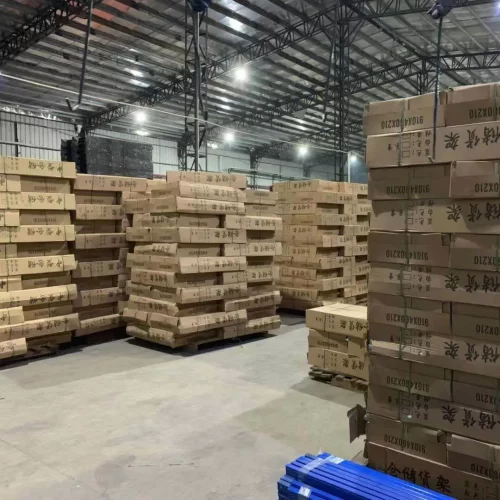WhatApp: +86 13713386306
Email: nancy@chinastoragerack.com
Phone: +86 18578478231
WeChat: +86 18578478231
Drive in racking is suitable for goods that can be stored on pallets behind or on top of each other, but ideal when greater access is required compared to block stacking. Pallets are stacked by the first-in, last-out (FILO) principle on supports mounted on both sides of the drive-in channels. This means that individual pallets cannot be accessed directly, but one by one from the front of the rack. As a form of block stacking, drive-in racking systems significantly increase the storage density in a warehouse. Consequently, the existing space can be used up to 90% more effectively than with conventional pallet storage systems. Click on the “Quick Quote” button below to get an instant price for a drive in rack.
| L*D*H (mm) | customizable |
|---|---|
| Layer | 3Layer, 4Layer, 5Layer, Customizable |
| Load Capacity | 1000kg, 2000kg, Customizable |
| Color | Blue, Orange, Customizable |
| Weight | Customizable |
| Volume | Customizable |
| MOQ | 10 sets |
| Estimated Delivery Time | 15-25 days |
Drive-in racking is a type of various warehouse racking, also known as drive-through racking, which is a kind of hot sale racking of Mracking Storage Equipment. The storage capacity is almost double that of the usual selective pallet racking in the same space. Drive-in racks are widely Used for bulk goods of the same type and package unitive, such as food, cigarettes and tobacco, home appliances, chemical plant, clothing manufacture and cold room, etc… Read drive-in racking system Design to design the right drive-in racking for your warehouse.
Drive in racking are difficult to install and require a professional racks installation engineering team to install. It is important to start at the bottom and work your way up. The first step is to install the rack upright frame; the second step is to install the cross beam and connecting rod to fix the upright frame; the third step is to install the bracket; the fourth step is to install the guiderail.

Punches run the length of the hanging plate at standard intervals where the cross beams are connected, most of them are 50mm or 75mm pitch.
Steel coil through the rolling equipment to form the upright and beam, beam usually have P beam and interlock beam, upright usually have diamond hole and teardrop hole.
Through welding, the hanging plate and beam; upright and footplate are closely connected together, which effectively strengthens the stability of the rack structure.
Polish the product after welding, then use electrostatic powder spraying technology on the surface, and finally use the high-temperature baking process to ensure a smooth surface.
Finally came to the last step. After the production of the product is completed, we usually package the exported goods to avoid long-distance transportation damage and seawater erosion during shipping.




Drive in racking system, also called drive through racking, is mainly first in last out, with a single variety, usually with a load of no more than 1.5 tons and a height of no more than 10 meters, usually with three to four layers. Drive in pallet racking, this kind of rack structure form can make forklift operation channel and goods storage space shared, greatly improving the warehouse space, site area utilization, but the same operation channel goods can not do first in first out, suitable for large quantities, less variety or operation channel goods flowing together to the same customer goods storage, such as beverages, dairy products, tobacco, low-temperature frozen storage, standard specifications of home appliances, chemicals, clothing, etc. Industry. According to statistics, drive in racking can achieve the maximum storage density, the effective utilization rate of space can be increased up to 90%, and the utilization rate of the site area up to 60% or more!
The dimensions of drive-in racking systems can vary depending on the specific requirements of a warehouse or distribution center. However, here are some general guidelines:
It is important to note that the dimensions of a drive-in racking system should be carefully designed to ensure that they meet the specific requirements of a warehouse or distribution center. Factors such as the size and weight of the products being stored, the available space, and the type of forklifts being used will all need to be taken into consideration when designing a drive-in racking system.
Drive in racking system is mostly used in the dairy industry, beverage industry and other food industries, and also more common in cold storage. Drive in pallet racking is a kind of integral racking that does not divide by channel and is continuous; drive in pallet racking adopts pallet access mode and is suitable for storing a single variety and large volume of goods; compared with pallet racking, the warehouse utilization rate can reach about 90% and the warehouse space utilization rate can be increased by more than 30%, which is the racking with the highest storage efficiency. On the support guiderail, pallets are stored in the depth direction, one right after the other. The investment cost is relatively low, suitable for larger horizontal size, less variety, more quantity, often used to store a large number of the same type of goods, due to its storage density on the ground space utilization rate is high, commonly used in cold storage, food, tobacco and other storage space costs high warehouse.
According to the summary of Mracking, drive in racking design considerations are the following four points.
First, the principle of maximizing space utilization: enterprise warehouses have their fixed costs, all want to do in the original warehouse area can be doubled to reduce costs, so drive in racking can maximize space utilization is an important principle of rack design.
Second, the goods-oriented, in line with the storage requirements is the focus of the design of drive in pallet racking: storage racks are based on the storage of goods, Mracking racks design engineers will have a full understanding of the enterprise storage goods, collect data on the specifications, size, weight and other data, as well as storage methods, according to the relevant data and information collected to design.
Third, a comprehensive understanding of the layout of the warehouse, design of a reasonable and scientific arrangement, and reduce the waste of space in dead ends, to achieve neat and beautiful.
Fourth, follow the principle of effective circulation and management of goods. Understand the warehouse management personnel on the management of goods, the development of a reasonable warehouse goods placement plan; understand the circulation of goods, manual or mechanical handling of goods, and aisle space reserved in accordance with the principle of first-in, last-out goods.
In addition, the drive-in racking requirements for the aisle: the main types of forklifts used in the drive-in racking are electric forklifts and counterbalanced forklifts, and if it is an electric forklift, the main aisle is normally about 3 meters, but if it is a counterbalanced forklift, then the main aisle must be at least 3.5 meters. The width of the specific racking aisle, that is, the width of the aisle for accessing goods, is generally 150mm larger than the pallet, that is, CE=L+150, CE is the net size of the racking aisle, L is the length of the pallet in the fork direction, 150 is equivalent to the side clearance of 75mm between the left and right ends of the pallet and the adjacent upright.
Shuttle racking and drive in racking are intensive storage equipment, in the current storage and logistics equipment, these two racks in bulk product warehouses, production processing industry, as well as e-commerce storage, cold storage warehousing is widely installed and used. Mracking racks technical department is pleased to introduce you the difference between shuttle racks and drive in racking. The difference between the storage methods of rack. As the name implies, it requires a forklift to drive into the interior of the rack aisle to access the goods; shuttle racking are different, shuttle racking work, the goods only need to use a forklift to transport them to the front of the shuttle racks, placed in the waiting shuttle car can be, through automatic operation to achieve storage.
There is a difference between the two in terms of the stability of the racking. In the case of drive in racking, the interior of the racking has fewer components to support stability due to the need for dense storage characteristics. As forklifts work inside, they are likely to touch the racks, causing them to shake and other problems. Because of the dense storage of goods, the higher up the racks, the greater the burden on the racks, so drive in racking are not recommended to be too high to improve their stability and safety. The shuttle car type racks, because of its automation requirements, will be more thorough consideration of security, and personnel basically do not need internal control, to minimize the threat to the safety of the racks.
Drive in racking is a kind of whole building type racking not divided by channel, with pallet goods storage, no special forklift channel, forklift needs to drive into the interior of the racking to access the goods, as for how much loading capacity of a layer is designed according to the weight of the accessed pallet goods, according to Mracking standards, usually drive in racking single pallet goods should not be too large, too heavy, usually the weight control within 1500KG, pallet span should not be greater than 1.5 meters, and drive in racking is usually single direction (against the wall area) the total depth of the racking control within 6 pallet depth, double direction (the middle area can be taken from both sides) the total depth of the racking area control within 12 pallet depth, so drive in racking a layer of loading capacity, single direction control within 9 tons, double direction control within 18 tons, the specific load can store pallet cargo characteristics to determine.
A. Cleaning timely discovery of racks through external collision of product mechanical deformation timely replacement of safe and stable rack parts, in the spirit of safety first guidelines, in the cleaning process timely discovery of safety hazards, timely processing, to ensure safe and efficient storage. B. maintenance cycle is one year. C. maintenance content for, fastener tightness determination, vertical column determination, damaged parts determination and other conventional content. If the column is bent (broken), the overall measurement is required. According to the measurement data for system maintenance. D. Correction with professional horizontal three-dimensional positioning tools, accurate records of the rack state, and then effective correction to ensure that the racking load-bearing capacity and safety. E. Strictly implement the rules of safe use, not over the load limit, over the line position, over the storage density, to ensure the safety performance of the storage process.
When using drive in racking system, loading and unloading are done from one side, which can effectively improve time efficiency. Drive in racking, a kind of whole racking that is not divided by aisles and is continuous, stores pallets in the direction of depth, one right after the other, on support rails (bracket), which makes high-density storage possible. Drive in racking is suitable for storage of goods with few varieties and large quantities, often used to store large quantities of the same type of goods, with high utilization of space, suitable for food industry, chemical industry, garment industry, cold storage and other occasions with high storage space cost, and its storage cost per unit site is relatively low.
Drive in racking has a set of pallet rack beams designed for forklift trucks that enter the rack from one end so that the driver can stack pallets in them. Drive in racking costs between $30 and $75 per pallet position, depending on depth. For example, a typical four-tier rack costs between $55 and $69. Please contact our sales Mr.Bradley (bradley@chinastoragerack.com) for specific pricing and he will design the best drive in racking for you and the best price.
Advantages of drive-in racking:
Disadvantages of drive-in racking:






Your email is absolutely secure and we’ll not disclose it to any third party for any reason.
Your email is absolutely secure and we’ll not disclose it to any third party for any reason.